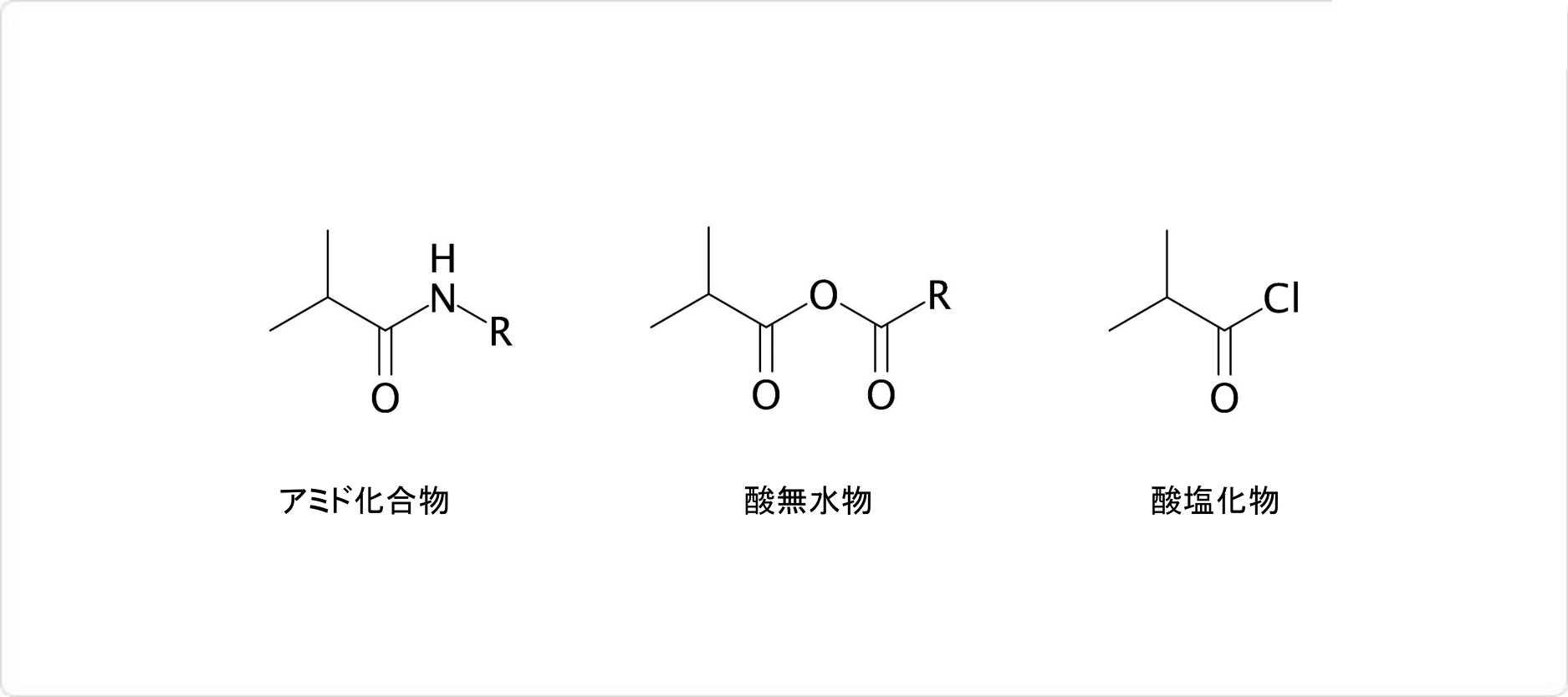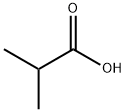-
外観
無色澄明の液体
-
種類
イソ酪酸は、一般的には研究開発用試薬製品や香料 (食品添加物) として販売されています。研究開発用試薬製品では、25mL、100mL、500mLなどの容量の種類があり、通常は実験室で取り扱いやすい容量で提供されている物質です。
室温で保管可能な試薬製品として取り扱われます。食品添加物・香料として販売されているものについては、メーカーへの個別の問い合わせが必要です。
-
性質
イソ酪酸は、分子量88.11、融点-47℃、沸点154℃であり、常温では無色の液体です。n-酪酸に似た、不快な腐敗バターのような臭気を持ちます。
密度0.950g/mL、酸解離定数pKaは4.84です。、エーテル等の有機溶剤に極めて溶けやすく、6倍の水に溶解します。。
-
溶解性
6倍の水に可溶。エタノール, エーテルに易溶。エタノールに極めて溶けやすく、水に溶けやすい。
-
解説
イソ酪酸は,植物の精油中に遊離またはエステルとして存在する.イソプロピルアルコールから容易に合成される.液体.沸点154 ℃.0.9504.1.3930.pKa 4.85.水に難溶,エタノール,クロロホルム,エーテルに可溶.正酪酸同様の性質を有する.この酸化を実験室的に行うには、酸化剤として過マンガン酸カリウムを用いる。合成香料、ワニスの製造原料となる。
-
用途
着香料、有機合成原料。
-
用途
極性溶媒、ジイソプロピルケトン合成の出発物質、除草剤、塩類は線維織物化学製品、皮なめし剤、安定化剤、触媒及び促進剤、エステル類は、香水の溶媒及び航空機タービン用の特殊オイル
-
製法
実験室的には、イソブチルアルコールをアルカリ性で過マンガン酸カリウムにより酸化すると得られる。工業的には、ブタノール(ブチルアルコール)やブチルアルデヒドを酸化して合成している。
-
合成

図2. イソ酪酸の合成の例
イソ酪酸は、イソブチルアルコールを適切な酸化剤 (二クロム酸カリウム/硫酸条件など) を用いて酸化することによって合成が可能です。この際、中間体としてイソブチルアルデヒドを経由します。
その他の方法では、プロピレンのヒドロカルボキシル化 (Koch反応) が挙げられます。工業的には、イソ酪酸はn -ブタノール製造時の副生成物として得られる物質です。
実験室的製法では、塩基性条件でイソブチルニトリルを加水分解してイソブチルアルコールを得た後に酸化する方法や、メタクリル酸をナトリウムアマルガム (Na(Hg)) で処理して直接イソ酪酸を得る方法などがあります。
-
化学的特性
Isobutyric acid is a clear colorless oily liquid with an odor and flavor similar to n-butyric acid. Miscible with water, soluble in ethanol and ether. Prepared via oxidation of isobutyl alcohol.
-
物理的性質
Isobutyric Acid is a flavoring agent that is a colorless liquid with a strong, penetrating odor, resembling butter. it is miscible in alcohol, propylene glycol, glycerin, mineral oil, and most fixed oils and soluble in water. it is obtained by chemical synthesis. it is also termed isopropylformic acid.
-
天然物の起源
Isobutyric acid occurs naturally in Ceratonia siliqua L. The gum obtained from the kernels of this species is used as a thickener in the food industry. Reported found in several essential oils: Arnica montana, Roman chamomile, Laurus nobilis, imperatoria, and in carob fruits (Siliqua dulcis); also identified in the essence of Seseli tortuosum, Artemisia transiliensis.
-
製造方法
Isobutyric acid is prepared in a similar way to butyric acid, mainly by direct oxidation of isobutanol and isobutyraldehyde, which is obtained by a direct oxidation reaction with air or oxygen.
-
定義
ChEBI: Isobutyric acid is a branched fatty acid comprising propanoic acid carrying a methyl branch at C-2. It has a role as a volatile oil component, a plant metabolite and a Daphnia magna metabolite. It is a branched-chain saturated fatty acid, a methyl-branched fatty acid and a fatty acid 4:0. It is a conjugate acid of an isobutyrate.
-
主な応用
Isobutyric acid is mainly used in the synthesis of isobutyric acid esters, such as methyl isobutyrate, propyl ester, isoamyl ester and benzyl ester. It can also be used manufacture of esters for solvents, flavors and perfume bases, disinfecting agent, varnish, plasticizers, deliming hides, tanning agent and used in pharmaceutical. Isobutyric acid has some important derivatives that, in the industry, is actually used for the production of isobutyronitrile intermediates, and then converted to isobutylamidine hydrochloride that is the raw materials of pesticide diazinon.
-
一般的な説明
Isobutyric acid appears as a colorless liquid with a light odor of rancid butter. Flash point 132°F. Density 7.9 lb / gal. Corrosive to metals and tissue.
-
空気と水の反応
Flammable. Water soluble
-
反応プロフィール
Isobutyric acid corrodes aluminum and other metals. Flammable hydrogen gas may accumulate in enclosed spaces in which this reaction has taken place [USCG, 1999].
-
危険性
Toxic by ingestion, strong irritant to tissue.
-
健康ハザード
Inhalation causes irritation of nose and throat. Ingestion causes irritation of mouth and stomach. Contact with eyes or skin causes irritation.
-
火災危険
Flammable/combustible material. May be ignited by heat, sparks or flames. Vapors may form explosive mixtures with air. Vapors may travel to source of ignition and flash back. Most vapors are heavier than air. They will spread along ground and collect in low or confined areas (sewers, basements, tanks). Vapor explosion hazard indoors, outdoors or in sewers. Runoff to sewer may create fire or explosion hazard. Containers may explode when heated. Many liquids are lighter than water.
-
使用用途
化学分野では、イソ酪酸メチルやプロピルエステル、イソアミルエステル、ベンジルエステルなどのイソ酪酸エステルの合成、イソブチロニトリル中間体の製造に使用される物質です。
また、食品分野では食用フレーバーとして用いられます。具体的には主にバター、リンゴ、キャラメル、チーズ、パン、酵母などの製造です。他にも、香水や香水エステルの原料や、医薬品、塗料用溶剤、消毒剤、ワニス、可塑剤、皮革、なめし剤の製造に用いられています。
-
化学反応

図3. イソ酪酸の誘導体の例
イソ酪酸は、カルボン酸一般に見られる典型的な反応性を示し、アミド(-CONH2)、酸無水物 (-CO-O-CO-)、酸塩化物 (-COCl) などの誘導体を生じます。また、クロム酸との反応ではアセトンが生成します。なお、イソ酪酸を塩基性条件下にて過マンガン酸カリウムで酸化して得られる物質は、α-ヒドロキシイソブチル酸です。
-
有害性と取扱い上の注意
イソ酪酸は種々の有害性があり、GHS分類では下記のように分類されています。
- 引火性液体: 区分3
- 急性毒性(経口) : 区分3
- 急性毒性(経皮) : 区分3
- 皮膚腐食性/刺激性: 区分1
- 眼に対する重篤な損傷性/眼刺激性: 区分1
- 特定標的臓器毒性 (単回ばく露) : 区分3
- 気道刺激性: 区分3
- 水生環境有害性(急性) : 区分3
- 水生環境有害性(慢性) : 区分3
また、イソ酪酸は、光によって変質する恐れがあるとされており、高温、直射日光、 熱、炎、火花、静電気、スパークを避けることが必要です。強酸化剤は混触危険物質に指定されています。危険有害な分解生成物は一酸化炭素、二酸化炭素です。
-
法規制情報
イソ酪酸は前述の有害性のため、法令によって規制を受ける物質です。消防法では、危険物第四類・第二石油類・危険等級Ⅲに指定されており、労働安全衛生法では危険物・引火性の物に指定されています。法令を遵守して正しく取り扱うことが必要です。
参考文献
-
合成
The preparation of isobutyric acid is similar with butyric acid, which is performed by the direct oxidation of isobutyl alcohol and isobutyraldehyde. Isobutyric acid can be directly generated from the oxidation of isobutyraldehyde in air or oxygen. Other manufacturing methods have isobutyronitrile hydrolysis and methacrylic acid hydrogenation. The oxidation of 2-methyl-1-nitropropane to prepare isobutyric acid can also obtain a higher yield. The purification of Isobutyric acid can be realized by azeotropic distillation with water, and anhydrous isobutyric acid can be obtained by the extractive distillation from carbon tetrachloride. Propylene and formic acid ester can react at 50 °C with the catalysis of hydrofluoric acid to generate methyl isobutyrate and propyl isobutyrate.
-
純化方法
Distil the acid from KMnO4, then redistil it from P2O5. [Beilstein 2 H 288, 2 I 126, 2 II 257, 2 III 637, 2 IV 843.]





